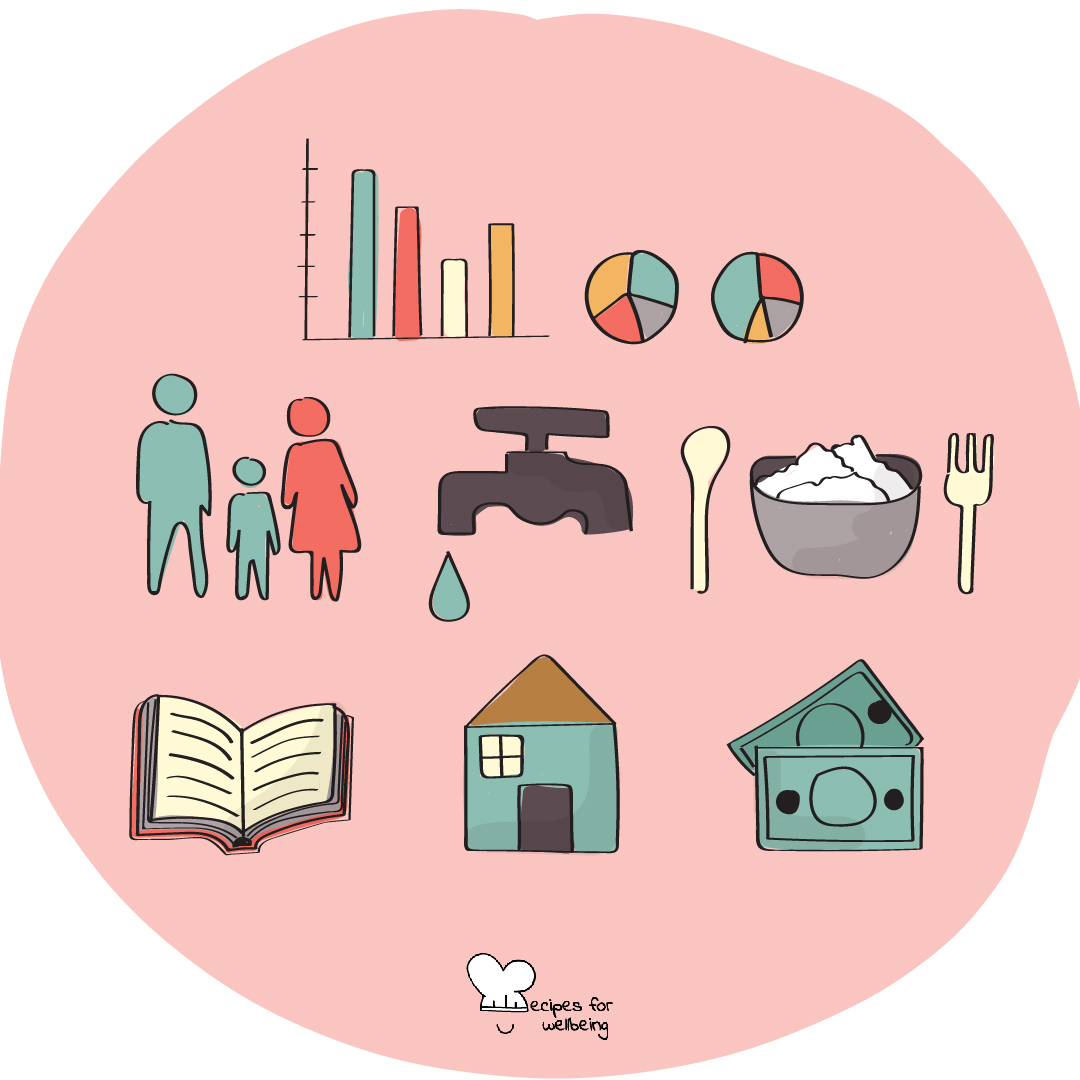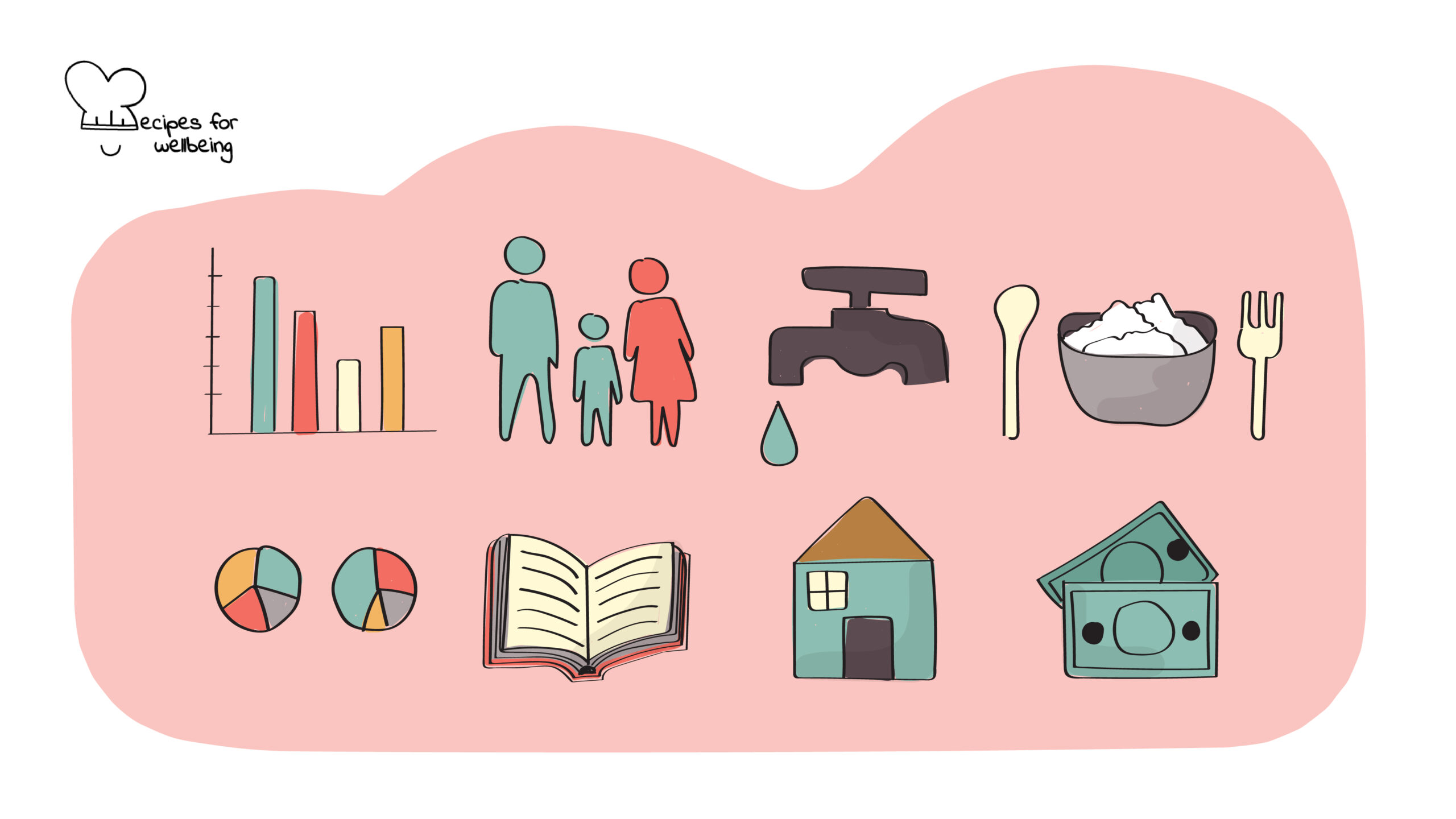
Multidimensional Poverty Index
Poverty is multidimensional. It extends beyond money incomes to education, health care, political participation, and advancement of one’s own culture and social organisation. ―Atal Bihari Vajpayee
👥 Serves: 26-40 people, 41+ people
🎚 Difficulty: Medium
⏳ Total time: Half a day
🥣 Ingredients: 1 data collector/survey administrator, teamwork, open mindedness
🤓 Wholebeing Domains: Bioempathy, Community, Liberatory Learning, Radical Care
💪 Wholebeing Skills: Acknowledgement, Challenging, Ecosystem harmony, Empathy, Fairness, Feedback, Hosting conversations, Liberation, Reflection

Multidimensional Poverty Index
📝 Description
Understand the multidimensions behind poverty.
Traditionally, poverty is seen as just an absence of money. Yet, it is a multi-faceted experience with underlying causes and constraints. People living in poverty face extensive challenges. For example, poverty is a factor behind ill-health and a barrier for accessing health care. It becomes cyclical as folks living in poverty are unable to reach wellbeing factors including good health, good quality food, and health care. Community leaders, as well as local, regional, and national policy-makers need to understand the multidimensions behind poverty to develop resources, policies, programmes, and interventions that are effective, appropriate, and realistic.
The Multidimensional Poverty Index (MPI) assessment strives to discuss and research poverty in a new light. It is an analytical tool that helps to identify people who experience poverty, how they experience it, and trends or patterns for similar groups of people.It assesses non-income-based dimensions of poverty, for a more comprehensive evaluation of the extent of poverty and deprivation.
This measurement tool is designed to be used at various stages of a community project or research: for example, at the start for baseline poverty studies, situation analysis, and project design; during the project implementation for mid-course correction; and at the end to track long-term community outcomes and poverty alleviation. The tool is universal enough to be relevant for most contexts, yet specific enough to provide useful data relevant to local poverty alleviation efforts.
This recipe has been inspired by the work of the UN Sustainable Development Solutions Network, and adapted by our wellbeing content writer collaborator Marissa Del Mistro.
👣 Steps
Step 1 – Understand MPI factors (1 hour)
MPI’s theoretical thought is that all humans, rich or poor, across countries and cultures, have fundamental needs. Consequently, six of MPI’s components have their roots in the Basic Needs Theory, which discusses the measurement of poverty in developing countries and communities. The Basic Needs Theory attempts to understand the absolute minimum resources that are necessary for folks to experience long-term physical and emotional wellbeing. These are as follows:
- Food and Nutrition Security which measures the consistency and availability of adequate or realistic quantities of adequately nutritious food.
- Domestic Water Supply which measures the quality of water available for drinking, cooking, bathing, and cleaning as well as the consistency of the supply, and the household’s access to it.
- Health and Health Care which measures an area’s health status, access to health care, and the quality of the care provided.
- Sanitation and Hygiene which measures the quality of the household’s sanitation (toilet facilities), waste management, and personal hygiene practices.
- Housing, Clothing, and Energy which measures the general quality of the household’s home (resilience to weather, etc.), the availability of adequate clothing, and the energy sources used in the home.
- Education which measures the quality, availability, and access to primary education.
There are then four additional features, which attempt to be inclusive of the varied careers and social-economic status of modern life. These are:
- Farm Assets which measures the household’s general ability to produce food and/or create farm-based wealth through crops, and/or livestock and/or aquaculture.
- Non-Farm Assets which measures the household’s non-farm wealth-generating ability, through employment, remittances, skills, access to credit, and household wealth.
- Exposure and Resilience to Shocks which measures the household’s exposure to natural and socio-economic shocks, hazards, and the household’s ability to cope and recover. This relates a lot to the natural disasters of the modern world due to the growing threat of climate change.
- Gender and Social Equality which measures the equality of access to education and health care for women and men, as well as equality across minority/ethnic groups.
It is possible to attempt adding additional measurements, should there be a specific need for your community.
Step 2 – Use the survey (1 hour)
The survey will be long and comprehensive to incorporate all aspects of the 10 dimensions. You can refer to the International Fund for Agriculture (IFAD) survey for inspiration on where to get started.
Survey questions, which are based on the topics listed in step 1 (there may be some intersection) should look like this:
- Health and Health Care/Gender Equity: For the majority of the households in your village/area, do you think there is a better chance for women or men to receive health care when needed?
- Education: Can your household afford your children’s school fees and school supplies?
- Health and Health Care How much time does it take for members of your household to reach the nearest health centre that can diagnose simple illness, or treat simple injuries and prescribe basic medicines?
- Housing, Clothing, and Energy: What is the primary source of light your home uses when it is dark?
- Exposure and Resilience to Shocks/Sanitation and Hygiene: What does your household usually do with non-food waste/garbage?
- Domestic Water Supply: How often do you worry there will not be enough water from your household’s main water source to satisfy your household’s drinking and cooking needs?
- Food and Nutrition Security: During the last 12 months, did any member of your household eat fewer meals, or smaller portions, than usual because there was not enough food?
- Housing, Clothing, and Energy: Does your household have a television?
Step 3 – Complete the surveys (30’ per respondent)
The survey is typically done as an interview, with the data collector asking the questions, in order to interact with respondents in a meaningful way, which can be done in approximately 30 minutes per respondent.
To be culturally sensitive, the data collector should be trained in working with vulnerable populations with varied needs. Sometimes, communities opt to work closely with local staff, local leaders or chiefs who are very well connected and have the nuances and deep-rooted trust with the people in the area to ensure honesty and comfortability.
Once the data is collected, survey responses are assigned numerical values, with 100 being the best/high score.
Step 4 – Work with the data (2 hours)
Accomplishing the goals of a poverty alleviation project requires accurate information on the target area and the population’s poverty situation which would have been collected in steps 1-3.
The information below is best completed with the help of an individual with monitoring and evaluation experience.
MPI can provide a useful overview of an area’s poverty situation, even if projects only focus on a few elements of MPIs 10 dimensions. This data, which is both qualitative and quantitative, can help with:
- Stakeholder’s involvement and understanding.
- Baseline data for monitoring changes over time.
- Basic demographic information.
- Snapshot of the poverty situation.
- Data-driven diagram of a community’s needs.
- Data of community strengths and weaknesses, in terms of both local infrastructure and community behaviour.
- Way to confirm or question previously held perceptions about poverty in the region.
- Determine optimal resource allocation among sectors and advocate increased funding in certain areas, based on identified needs.
- Improving participatory decision-making, based on accurate information about a community’s poverty situation.
- Facilitating decisions on interventions needed to address specific needs.
- Offering a ready-made tool, so that a project team may use it in designing its primary monitoring and evaluation system.
Monitoring and evaluation purposes: For a poverty alleviation project to be successful, it requires a strong planning and design process. Though there are many different ways to evaluate a project, the overall purpose and goals of M&E remain the same:
- To keep project work streamlined, accurate and focused on goals, programme, and strategy.
- Identify if activities are doing their job and effect, and make changes if necessary,
- To hold projects accountable.
- To provide solid information for sound decision-making at all levels.
- To generate learning for the diverse stakeholders involved.
Comprehensive M&E systems are often thought of in terms of the classic input output-outcome-impact framework, as follows:
- Inputs: What is used to do the work of a programme, such as personnel, training curricula, transport, funding, etc.
- Outputs: What the programme provides or delivers. This will be based on your unique programme, like the number of knowledge/training activities, the number of vaccinations distributed, the number of health clinics built, and the number of fertiliser bags given out. Outputs are often thought of as ‘units of service’ but can also be represented by physical infrastructure.
- Outcomes: What the programme hopes to achieve based on its activities, such as behaviour change in teachers/students, a decrease in the incidence of disease or illness, or an increase in agricultural productivity. They are often related to knowledge, skills, attitude, or behaviour change, and describe the benefits for participants during or after their involvement in the programme. Outcomes are often thought of as a progression over time and tend to be characterised in terms of short-term, intermediate, and long-term outcomes.
- Impacts: The long-term and broader changes that can be shown to be caused by the programme itself.

